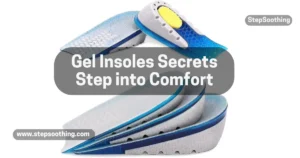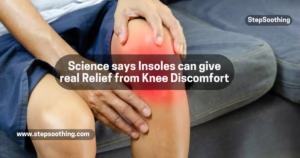Wearing the right insoles can make a huge difference in foot comfort, support, and alignment. They help in pain reduction, injury prevention, and overall foot health by improving how your feet function inside your shoes. Whether you are dealing with Plantar Fasciitis, arch pain, or flat feet, the right insoles can provide relief and improve mobility.
Selecting the correct shoe inserts is essential to avoid discomfort and foot-related complications. People with high arches, overpronation, or supination require specific insoles to enhance stability and shock absorption. Not only athletes but also retail workers, runners, and individuals standing for long hours can benefit from motion control insoles designed to reduce muscle fatigue and joint pain.
How to Pick the Perfect Insoles for Your Feet

Understanding Different Types of Insoles
Arch Support Insoles
Different arch types require different levels of support. If you have flat feet, structured Arch Support Insoles can prevent overpronation and discomfort. For high arches, cushioned insoles provide the necessary shock absorption to reduce stress on the feet.
Cushioning Insoles
For those who prioritize comfort over support, cushioned inserts offer extra padding, reducing the impact of walking, running, or standing for long hours. Materials like Memory Foam, polyurethane foam, and gel insoles help with pressure relief and heel cushioning.
Orthotic Insoles
Custom Orthotics are recommended for individuals with medical conditions such as Achilles tendonitis, bunions, Morton’s neuroma, heel spurs, and hammer toes. These insoles correct biomechanical imbalances and improve gait correction.
Sports Insoles
Designed for athletes and runners, sports insoles enhance shock absorption, muscle support, and structural stability. They prevent joint strain and help with fatigue reduction during high-impact sports activities.
Work Insoles
Workers standing for long hours, especially in retail, healthcare, or construction, need anti-fatigue insoles to minimize foot fatigue, lower body pain, and joint strain. Forefoot support and heel cushioning in these insoles provide all-day comfort.
Key Factors to Consider When Choosing Insoles
Foot Type & Arch Support
Identifying your foot type is crucial before choosing insoles. Use the wet foot test to determine whether you have a flat foot, high arch, or normal arch. Matching the arch structure to the right insole improves foot alignment and posture correction.
Material & Durability
- Memory foam: Offers comfort, pressure relief, and cushioning.
- Gel insoles: Enhance impact absorption and help with heel pain.
- Cork or leather: Provide durability and mold to the foot shape over time.
- EVA (Ethylene Vinyl Acetate): Lightweight and ideal for sports shoes.
- Polypropylene and carbon fiber: Offer structural support and longevity.
- Vegan cactus leather: A sustainable option with breathability and moisture control.
Fit & Shoe Compatibility
Ensuring a proper shoe fit is essential for comfort and effectiveness. Choose between trim-to-fit or pre-sized insoles depending on your needs. Insoles should match different footwear types, including casual shoes, dress shoes, sports shoes, and work boots.
Support vs. Cushioning
Choosing between firm support and cushioned insoles depends on your needs. If you suffer from pain due to structural abnormalities, opt for orthotic arch supports. If you need additional comfort, cushioned arch supports are better suited.

Common Foot Problems & Recommended Insoles
Plantar Fasciitis
For plantar fasciitis, opt for orthotic insoles with deep heel cups and arch support to reduce heel pain and improve foot function.
Flat Feet
If you have flat feet, choose structured arch support insoles to prevent overpronation and provide proper foot alignment.
High Arches
People with high arches should use cushioned insoles that provide shock absorption and ease pressure on the forefoot and heel.
Heel Pain
Gel inserts or memory foam insoles help relieve heel pain by providing extra cushioning and support.
Expert Tips for Maximizing Insole Benefits
Break Them In
New insoles may take time to adjust to your feet. Gradually wearing them over a few days allows your foot alignment to adapt to the support and cushioning.
Regular Replacement
Replace insoles every 6-12 months, depending on usage and wear. Over time, they lose their shock absorption and support, affecting foot comfort.
Consider Custom Insoles
If you have severe foot conditions, consult a podiatrist or foot surgeon for custom orthotics that cater to your specific needs.
Ensure Proper Shoe Fit
Make sure your replacement insoles fit well inside your shoes without crowding or altering the shoe fit.
Maintenance Tips
- Cleaning: Regularly wash insoles to prevent foot odor and bacteria buildup.
- Drying: Allow insoles to dry completely before placing them back in footwear.
- Storage: Keep insoles in a dry place to extend their lifespan.

Meet the Experts
When it comes to foot health, these experts have dedicated their careers to helping people walk, run, and stand comfortably. Their knowledge in podiatry, orthopedics, and sports medicine makes them the perfect guides for choosing the right insoles and footwear.
- Dr.Jacqueline M. Sutera, DPM – A board-certified podiatrist at City Podiatry in New York City, Dr. Sutera specializes in women’s foot care. She has shared her expertise on supportive shoes, including whether Hokas are a good choice for foot health.
- Dr.Bonnie Chien – As an orthopedic surgeon at New York-Presbyterian/Columbia University Irving Medical Center, Dr. Chien focuses on foot and ankle conditions. She has provided insights on selecting high-quality shoes, especially for people like nurses who stand for long hours.
- Dr.Ernest L. Isaacson, DPM PC – A well-known podiatrist in New York, Dr. Isaacson is a fellow of the American College of Foot and Ankle Surgeons and the American Society of Podiatric Surgeons. He has previously discussed key features of high-quality socks and their role in foot health.
- Dr.Stephen Pribut– A clinical professor of surgery at George Washington University School of Medicine, Dr. Pribut is an expert in biomechanics, sports injuries, and foot health.
- Dr.Tracey Vlahovic – A clinical professor of podiatry at Temple University in Philadelphia, Dr. Vlahovic specializes in foot conditions and offers guidance on managing common foot problems.
- Dr.Carl Giordano – Co-founder and chief science officer of Rebesana, Dr. Giordano is double board-certified in spine surgery and orthopedics, bringing a broad perspective on foot alignment and posture.
These professionals bring a mix of medical expertise, athletic experience, and practical advice to help you make the best decisions for your foot health and comfort.
Best Brands and Where to Buy Insoles
When selecting insoles, it’s important to choose a high-quality brand known for comfort and durability. Here are some of the best brands:
- Superfeet: Specializes in arch support insoles with deep heel cups for stability.
- Dr. Scholl’s: Offers a variety of cushioned insoles and shock absorbers for daily wear.
- Powerstep: Known for orthotic arch supports and motion control insoles for foot alignment.
- Spenco: Produces high-quality cushioning insoles ideal for forefoot pain relief.
- SOLE: Provides custom insoles that mold to your feet, ensuring a perfect shoe fit.
- WalkHero: Focuses on plantar fasciitis relief and foot fatigue reduction.
Where to Buy
You can purchase these insoles from trusted online retailers like Amazon and Zappos, as well as sports stores, pharmacies, and foot care shops for expert guidance on the best fit for your needs.
Making the Right Choice
To make the most of your insoles, choose the right one for your foot type, arch structure, and comfort needs. Look for trusted brands and materials that provide the best mix of cushioning, alignment, and support. Whether you need stability for sports activities, pain relief for foot conditions, or added comfort for long hours on your feet, the right insole can greatly improve your mobility and quality of life. Replace them regularly, clean them often, and always prioritize a comfortable fit for the best results.
People Also Asked
How do I know which insole is best for my foot type?
You can determine your foot type by performing a wet foot test. If your footprint shows your entire foot, you likely have flat feet and need arch support insoles to prevent overpronation. If your footprint shows only the heel and forefoot, you likely have high arches and need cushioning insoles for shock absorption. Those with a normal arch should opt for balanced arch support insoles for both stability and comfort.
What is the difference between orthotic insoles and regular insoles?
Orthotic insoles are designed for individuals with foot conditions like plantar fasciitis, Achilles tendonitis, bunions, and Morton’s neuroma. They provide structural support, gait correction, and pain relief. Regular cushioning insoles are mainly for shock absorption and foot comfort and are ideal for athletes, workers, and people who stand for long hours.
How often should I replace my insoles?
The lifespan of insoles depends on usage and material. Generally, cushioned insoles (such as those made of gel or memory foam) should be replaced every 6 months, while firm support insoles made from EVA foam, polypropylene, or carbon fiber may last up to 12 months. If you notice foot fatigue, reduced comfort, or visible wear, it’s time for a replacement.
Can I use the same insoles for all my shoes?
Not all insoles fit every shoe type. Some are designed specifically for sports shoes, casual shoes, dress shoes, or work boots. Look for trim-to-fit insoles for versatility or choose pre-sized insoles that match your shoe size. Always ensure that the shoe fit remains comfortable and that the insole does not crowd the shoe.
Where can I buy high-quality insoles?
You can purchase reliable footbeds and shoe inserts from Amazon, Zappos, pharmacies, sports stores, and specialty foot care shops. Buying from reputable brands like Superfeet, Dr. Scholl’s, Powerstep, Spenco, SOLE, and WalkHero ensures you get genuine, high-quality products that provide the right comfort, support, and durability.



